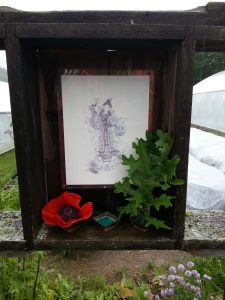I’ve been wanting to get my hands dirty in Karmê Chöling’s organic garden since I arrived two months ago. It grows on one acre of soft, enthusiastic soil that hugs a bend on the Stevens River — in the Green Mountains of northern Vermont — with neat rows of spinach, radicchio, leeks and celery. Crops are planted as straight and smart as a line of Kasung, standing knee-high in a swaying patch of wildflowers.
Amanda Perez, Karmê Chöling’s barefoot garden manager, tells me there are more than a hundred varieties of vegetables, flowers, herbs and mushrooms (and weeds) that grow at this Shambhala meditation center, along with one tricky groundhog and a bird population that chirps a symphony from every direction but down.
Besides growing food for hungry practitioners, and providing an outdoor classroom for learning the fundamentals of organic gardening, Master Gardener Jan Enthoven says his intentions for the garden are simple:
“Wake people up and provide beauty,” says Jan, who’s been teaching and gardening at Karmê Chöling nearly 30 years. “Waking up happens with the gaps between thoughts. I try to encourage noticing those gaps.”

Karmê Chöling garden manager Amanda Perez gets her hands and feet dirty in the garden, even in the rain.
After an hour of meditation, the garden crew begins each morning with a chant to Yeshe Tsogyal, the mother of Tibetan Buddhism, at a shrine near the garden’s gate. Jan also gives them a lojong slogan to chew on most weeks, such as “Drive all blames into one,” which gardeners can contemplate while turning the compost or sticking tender new starts into the earth.
The garden crew says it’s unlike any garden or farm they’ve worked at before.
“But I suppose it’s not just any farm,” said Charles Passmore, a garden apprentice who will cap his apprenticeship with a month of meditation this fall. “It’s in a community with people meditating, where meditation’s a big focus.”
Charles brings the energy of the Shambhala Shrine Room to work with him most days.
“I think being in the garden is a meditative experience. There’s something about watching the cycle of birth and death, in terms of planting and harvesting, and then replanting, that feels like a connection to the cycle of life.”
On the morning I volunteer in the garden, Charles and I harvest spinach in a cool rain that breaks up the few hot, muggy days this spring has sprung. We pass the time talking about mind stuff, mostly about the aggravating things in our experience that give us a perspective on thought patterns, and help us wake up to how human minds can run so wild.
He told me he feels a sense of relief on the meditation cushion when he recognizes just how repetitive and trivial his thought patterns can be.
“They’re quite ridiculous, but it’s so easy to get caught up in them and feel that they’re part of you,” he tells me later, after changing into dry clothes and sitting down in the Karmê Chöling library. “It’s quite easy to get lost, and believe the thoughts are essential to who you are. And often they’re not helpful.”
Graham Reisbach, another apprentice, has been working in various gardens to make a living since he was 16.
Now 25, Graham has thoughts of one day opening a farm-to-table restaurant — much like Karmê Chöling, but on a commercial scale.
“It’s a particularly beautiful garden, the balance it has,” says Graham. “It’s not just for production, but it produces a lot of food. It’s not so much only for pleasure, yet it’s gorgeous and has beautiful flowers. It rides the line between production and beauty, which I love about it.”
Graham thinks it’s the community of practitioners at Karmê Chöling that sets its garden apart as something special.
“Everybody’s trying to do their best, to uplift their environment and one another, and care about one another,” Graham says. “It feels more like a playdate than work a lot of the time – there’s something very lighthearted about it.”
Marit Wilson, who is part of the garden staff and worked at small commercial farms before taking a job here, says there’s an efficiency at Karmê Chöling’s garden that manifests differently than at other organic farms.
“Every organic farm is struggling with the bottom line, and it’s really a hard Iife,” she says. “You work just as much as you possibly can, and you put as much time as you possibly can into making a good product – and you do it as fast as you can.”
But that kind of efficiency is not the goal at Karmê Chöling, she says. There’s space to think about more than the bottom line.
“I would say that Jan takes care of each seed – like each individual seed almost,” she says. “And if he sees one that’s out of place he’ll correct it. When a mistake is made, or there’s an aesthetic deviation, he’ll actually go back and correct it, or redo it. That’s something I’ve not experienced as much” at commercial farms.
Amanda sees the rhythm of the garden as an extension of her meditation.
“It’s sort of like this balance between not being speedy, but moving and being in tune with your body,” she says. “It’s not like traditional meditation, where you’re sitting and watching your thoughts, but we invite people to stretch their bodies and look up, and pay attention and notice what they see, and also to be embodied as they’re working.”
If you’re new to meditation or a longtime practitioner, and interested in experiencing life at a dharma center, you could do a lot worse than a staff or volunteer position in Karmê Chöling’s garden. Surrounded by a forest populated by deer and squirrel and snapping turtles, Karmê Chöling was founded by Shambhala’s founder, Chogyam Trungpa Rinpoche, for the purpose of waking people up. It’s one of the oldest retreat centers in the United States.
If you don’t like getting dirty, there are 40 core staff positions outside the garden just as essential to running the retreat center. Meals – supplemented by the garden – are included in the deal, along with lodging and a stipend, beautiful practice spaces and 28 days off each year to enroll in free programs aimed at all levels of meditators. There are also opportunities to work with teachers by staffing meditation programs.
The Garden Apprentice Program, which lasts six months, is also a good way to get a taste for living in a retreat center community.
“You can learn how to manage a garden this size by getting training here,” Amanda says. “I don’t think in one season you can learn everything you want to learn, but it’s a very comprehensive training.”
Apprentices are introduced to all aspects of the garden operation, from seed sowing, composting, and irrigation, to harvesting and garden planning. Apprentices are encouraged to take ownership of various tasks as their confidence grows and understanding deepens.
The curriculum includes:
- Seed Sowing and Plant Propagation
- Water and Irrigation
- The Soil Food Web
- Building Superior Compost
- Garden Design
- Soil Nutrient Balancing
- Crop Rotation Planning
- Pest and Disease Management
- Season Extension Methods
- Growing Mushrooms
Learn more about Karmê Chöling on the website. Links to the specific offerings and opportunities mentioned in this article are as follows:
- Garden ApprenticeshipKarmê Chöling’s garden
- Our month-long meditation retreats called Dathuns
- Working Here
- Other programs at Karmê Chöling

A morning of meditation is followed by work in the Karmê Chöling garden for Ciel Haviland, left, and Marit Wilson.
One Comment


 (802) 633-2384
(802) 633-2384

What a great article! Thanks to the garden team for keeping the offerings fresh!